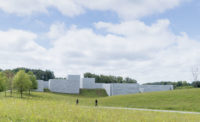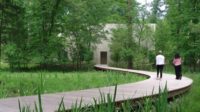Potomac, Maryland
A noticeable trend of late seems to be for major art collectors to create their own private museums, much as their Enlightenment forebears did in the 18th century. Instead of Horace Walpole, Sir John Soane, or Thomas Hope, however, you have Alice Walton (of the Wal-Mart family) building a new museum in Arkansas, designed by Moshe Safdie; newsprint mogul Peter Brant and his wife, Stephanie, turning to Richard Gluckman of Gluckman Mayner to renovate a barn for art at their Greenwich homestead; and Don Fisher, who enlisted Gluckman to design a new museum for his collection in the Presidio in San Francisco. The list goes on.
Glenstone, a 125-acre estate in Potomac, Maryland, is different from its cohorts. The art museum is a new structure conceived as part of a residential compound designed by one architect, Gwathmey Siegel & Associates. The collector, a Forbes 400–ranked industrialist, had first turned to Charles Gwathmey, FAIA, to design a New York City pied-a-terre for him, and admired the way the architect had integrated his art collection into the setting. This led to the design of a new house on the Potomac, along with a plan for a semiprivate museum that would display works by Willem de Kooning, Jackson Pollock, Jasper Johns, Robert Rauschenberg, Cy Twombly, and Robert Ryman, to name a few of the impressive cluster of 20th-century artists represented among the owner’s holdings. (The museum, which is run by the Glenstone Foundation, is open by appointment.) The architects and the client worked with landscape architect Peter Walker and Partners to create a paradisiacal totality from scratch, with an extensive sculpture park embedded in a bucolic setting straight out of Capability Brown.
The striking itinerary through architecture and landscape begins at the gate, where a long, curving driveway leads past sugar maple trees, wild flowers, and rolling hills. “We wanted to establish an unfolding sequence of views,” says Gwathmey. A large sculpture by Richard Serra, Contour 290 (2004), sits on one side, and Tony Smith’s Smug (1973/2005) on the other. The drive splits at the existing 2-acre pond, with a biomorphic shape that reappears as a design motif elsewhere in the complex. One serpentine leg of the drive leads to the main house; the other, to the museum.
In responding to the particuliarities of the site and the variegated program, which included a guest cottage and pool house, Gwathmey had the chance to rework architectural motifs he had developed over the years, as well as experiment with new formal notions. This opportunity may seem akin to Philip Johnson’s creation of his Glass House compound in New Canaan, Connecticut. But there, Johnson, as his own client, added the separate structures for an underground art gallery, a sculpture gallery, along with the Glass House and other assorted buildings from 1949 to 1995. Owing to Johnson’s shifting stylistic predilections, the result looks more like a group show than the assembled works of a single architect.





Post a comment to this article
Report Abusive Comment